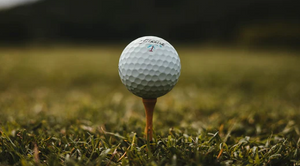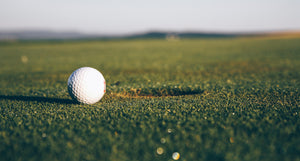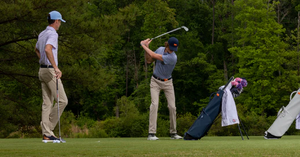Why Are There Dimples on a Golf Ball?
The evolution of golf balls has come a long way since the game's invention. Although the game of golf has been around since the 15th century, knowledge about golf ball optimization has developed slowly over the years.
One of those important discoveries that resulted from pure happenstance was that the small indentations on a ball could enhance its performance. This discovery revolutionized the game and how it was played.
Keep reading to find out how these peculiar-shaped balls came to be and all the answers to your questions about the dimples on a golf ball.
What Are the Small Indentations on a Golf Ball Called?
The perfectly placed indentations on a golf ball are called dimples, and each one serves a purpose way beyond aesthetics. Without this dimple pattern, the trajectory of a golf ball would look very different. The physics behind this design helps us understand how and why these small indentations are crucial to the game we play today.
Why Do Golf Balls Have Dimples?
The dimple pattern started as a happy accident, which we'll discuss further below. However, since the discovery of dimples’ significance, manufacturers have added them. Each indentation on a golf ball is now intentionally and symmetrically placed to improve its performance. These dimples are crucial to the design because they interact with the air around them and create microturbulence that allows the ball to travel in the air with more ease and predictability.
When a player hits a golf ball and sends it flying through the air, the dimples allow the airflow around it to stay closer to it. It reduces its drag, gives it a backspin, and creates those pockets of turbulence that cause an upward force and lift it higher.
The concept of airflow is better known as “Bernoulli's Principle.” This theory explains that as an object picks up speed, the air pressure surrounding it decreases. In turn, the object moves with less friction and goes further. Cars and airplanes also adhere to this principle, not just golf balls!
Have Golf Balls Always Had Dimples?
Golf balls haven't always looked the way they do today. You might be surprised to find out they once consisted of smooth leather sewn together by hand and filled with goose feathers.
These expensive, inefficient "feathery" golf balls lost their fame in the 1800s. In their stead, the “gutty” balls molded from dried tree sap took their place. These sphere balls were much easier and cheaper to produce but didn't soar as high as their predecessors when hit.
Over time, these balls would get beat up and worn down, yet golfers began to prefer the old dented ones because they noticed the flight of these balls was more controlled and could also reach longer distances in their damaged state.
After this realization, manufacturers eventually began to add indentations to their balls. However, it wasn't until 1905 that William Taylor filed the first patent for this design.
Since then, we've continued to improve and expand on this idea as we've discovered just how much of an effect this pattern has on a ball's aerodynamics.
Why Do Golf Balls Have Different-Sized Dimples?
Some features, such as the size and weight of a golf ball and the symmetricity of the dimples, must meet specific standards regulated by the United States Golf Association (USGA). According to the USGA, some of the requirements of a golf ball include symmetrical dimples, a ball size that does not exceed 1.68 inches in diameter, and a weight of no more than 1.62 pounds.
Other features like the pattern, depth, and number of dimples can vary depending on the model of the ball. Still, these characteristics do influence the overall performance of the ball.
So, what difference does the size of a dimple make? The main difference the dimple size makes in a ball is the expected trajectory and spin it will have when hit.
As a golfer, you must assess your strengths and weaknesses to determine what would work best for you for the golf ball type. If more height and spin on your ball would benefit the way you play, larger dimples would be the better choice. On the contrary, if you prefer your hits to have less spin and height, smaller dimples would be more suitable.
Frequently Asked Questions
What If a Golf Ball Has No Dimples?
As we mentioned, golf balls haven't always looked the way they do now! So how would a modern ball of today perform with no dimples? Well, a golf ball with no indentations would only travel half the distance and height of its dimpled counterpart.
Without these dimples, the ball would have very little to counter the aerodynamic drag, making the flight pattern unpredictable and hard to control once it leaves the club head. Also, because there's no texture to give it spin in the air, hitting one would produce a shot similar to a knuckleball flying low to the ground.
Does the Number of Dimples on a Golf Ball Matter?
The USGA has no restrictions on how many dimples a ball should have, but today, the best-rated, most popular golf balls carry about 300-400 dimples. Some models do exceed this number, carrying around 400-500+. One manufacturer currently holds the record high for the most dimples on a golf ball, coming in at 1,070 dimples!
Final Thoughts
To think, the design all started with scratches and dings on an old ball. They've come a long way since goose feathers and tree sap, and now you can find dimples in different numbers, sizes, and shapes like hexagons, circles, ovals, and teardrops. However you get them, the physics remains the same, and we owe the aerodynamic properties of the dimple pattern for enhancing the game we love!
For more interesting facts about golf history, check out the STITCH Golf blog. And when you’re ready to hit the course looking your finest, head to our online shop today for stylish golf apparel, bags, club head covers, and more.


